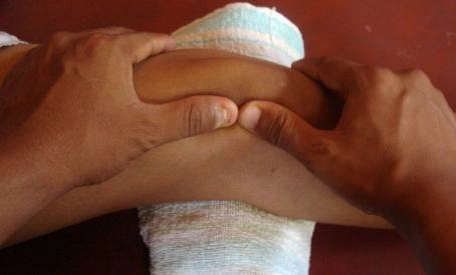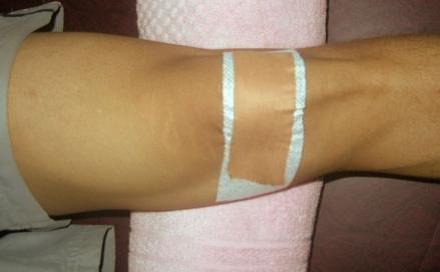Patello-Femoral Pain Syndrome: to tape or not to tape?
Posted on 10th February 2014 by Marissa Fedorcha

Khuman R, Devi S, Anandh V, Kamlesh T, Satani K, Nambi G. Patello-Femoral Pain Syndrome: A comparative Sudy of Mobilization Verses Taping. International Journal of Pharmaceutical Science and Health Care. 2012; 2(6): 89-96.
What is PFPS?
Patello-Femoral Pain Syndrome (PFPS) is a condition that typically presents as pain around or behind the patella (knee cap) that gets worse with walking, climbing stairs, squatting, sitting for long periods of time, going from sitting to standing, or with kneeling. Many things can be going on in the body that can cause this type of pain, such as weakness in the legs, over training, or even a misaligned knee cap. It is one of the most common conditions seen in younger people and many treatment options are available to help alleviate some of the symptoms associated with this condition.
Introduction
The purpose of this study was to compare the effects of a medial glide mobilization on the patella (Maitland mobilization) to a lateral glide correction taping technique (McConnell taping) in addition to exercise on reducing pain and improving function in patients with PFPS.
What’s the deal?
This study consisted of 50 subjects who were diagnosed with PFPS aged 20-30 years old who had to have at least 3/6 of the following: pain with walking, pain with stairs, pain with squatting, pain with going from sitting to standing, pain with kneeling, and pain with jumping and running. They were split into two even groups of 25 into either the McConnell taping group or the Maitland mobilization group. Each group received treatment on 12 different occasions for one hour each session. Both groups also received conventional therapy in addition to either taping or mobilizations that consisted of various exercises targeted at the leg that has PFPS. The main outcome measures were the visual analog scale (VAS) to measure pain and the knee outcome survey- activities of daily living (KOSADL) to measure function.
What did they do?

Medial glide mobilizations provided to the patella
The Maitland mobilization group was positioned on their backs with a towel roll under their knee and grade I and II medial glide mobilizations were provided to the patella. A medial glide was performed as it has been noted to be the most restricted movement.
The McConnell taping group was positioned the same as the mobilization group but received taping to the patella to correct lateral glide misalignment. There was an under wrap that was applied followed by a strip of corrective tape.
Conventional therapy included passive stretching to the quadriceps, stretching to the lateral thigh muscles, strengthening exercises to the quadriceps, and ultrasound to the front of the knee.
What did they find?
The results of this study showed that both mobilization and taping were helpful in reducing pain and improving function in patients who have PFPS. However, it was noted that those who received taping had an even bigger improvement in pain and function. The authors state that this could be because once the patella was realigned correctly in the taping group, there was better muscle activation that in turn provided pain relief.
Drawbacks
The results from this study should be taken with a pinch of salt. This study would be very difficult to reproduce, which makes the information provided fairly weak and of little clinical significance. The detail provided throughout the article was vague at best and that makes it difficult to know if the results have any true meaning. Subjects received 12 sessions of treatment, but over what period of time? Was it over 4 weeks? 12 weeks? We don’t know. The description of how each intervention was applied doesn’t have enough information in it for someone to come in and reproduce that same intervention. How long were mobilizations applied and how many times during each hour? Since taping shouldn’t take an hour, were those patients receiving more exercise than the mobilization group? The exercises both groups received were vague and only mentioned some muscles or body parts that are targeted and did not mention specific exercises or a frequency and duration. This is all very valuable information that is necessary for someone to be able to reproduce this study or to use the results to assist in treating someone with PFPS.
Take home message:
This article left me with a lot more questions than answers. Just jumping to the results shouldn’t give anyone enough information to use or not use a specific intervention in their practice. The results of this study sound great– you can use mobilizations or taping and you will get positive results in your patients with PFPS regardless what you choose. However, there are several things about this study that make it not so great, so caution should be taken when reading any research article. Although I wouldn’t say this was a great study, I would still consider both taping and mobilizations in my practice for treatment of patients with PFPS. Research is just one piece of the clinical puzzle, and I have had success in the clinic with mobilizations so far in my clinical career. Staying on top of the current research is crucial and I think it’s important to have many tools in your toolbox when treatment patients with any condition.





No Comments on Patello-Femoral Pain Syndrome: to tape or not to tape?